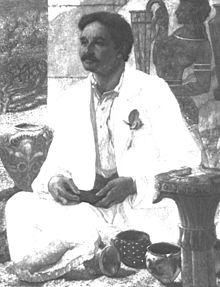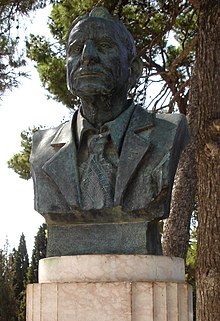Arthur Evans
Sir Arthur John Evans (born July 8, 1851 in Nash Mills , Hertfordshire , † July 11, 1941 in Youlbury , Oxfordshire ) was a British archaeologist . Evans is considered to be the discoverer of the Minoan culture . He was best known for the excavation and exploration of the Minoan palace of Knossos at the beginning of the 20th century on Crete .
Life
Arthur Evans was the son of the British archaeologist John Evans and his wife Harriet Ann, a daughter of John Dickinson , the inventor of mechanical papermaking and founder of the company John Dickinson & Co. Arthur Evans married the daughter of the historian Edward Freeman .
Evans became director of the Ashmolean Museum at Oxford in 1884 , a position he held until 1908.
In 1889 the Ashmolean Museum was offered for sale by John Greville Chester , a traveler who traded in archaeological finds, including a red carnelian seal stone . Evans recognized symbols made up of figurative details and objects that were difficult to identify on the stone. He considered the signs to be Anatolian - Hittite or Hittite-Syrian - from the 2nd millennium BC. BC, but learned from Chester that the seal stone was found in Sparta . Evans bought the seal stone. Four years later, he was offered several copies of similar seal stones in Athens , which were said to have come from the island of Crete . Evans turned to Adolf Furtwängler and received from him a number of seal impressions with the same pictorial writing, the origin of which was also Crete. Evans also received knowledge of a two-sided gem with similar hieroglyphs from Crete , which was in the possession of Archibald Henry Sayce .
Enthusiastic about the discovery of Troy by Heinrich Schliemann and inspired by Arthur Milchhoefer's theory of a Bronze Age high culture, Evans traveled to Crete in March 1894 and explored the interior of the island from Candia , such as the Ida Mountains , the Dikti Mountains and the south of the Messara plain . He gained knowledge of over twenty ancient cities and acquired objects from the Minoan period such as seal stones, gems and impressions of Cretan hieroglyphics from the locals . Among the rural population, mostly young mothers, for example, pierced Minoan seal stones on ribbons were worn around their necks, called "milk stones" and which were ascribed magic power. Evans also discovered another type of character that looked like letters on gems and ceramic shards.
From 1895 to 1900 Evans bought a plot of land on the hill Kephala south of Candia (Heraklion), on which, in his opinion, the ruins of Knossos , mentioned by Homer , were located. Fragments of painted stucco, ceramic shards, a gold ring and a vessel made of steatite had already been found there. Even before Evans, the Cretan Minos Kalokairinos uncovered large clay barrels between stone walls on the Kephala and the American journalist William J. Stillman came across old stonemason's marks there. On March 23, 1900 Evans began the excavations and hired 30, later 100 workers at his own expense. The men uncovered a magnificent palace with numerous frescoes , which Evans attributed to the mythical King Minos . Evans later had parts of the ruins "reconstructed" into buildings (that is, by adding additions to the shape he believed to be the "original"), which even then caused a lot of criticism. Here, Emile Gilliéron and his son Emile (1885–1939) played an important role in the restoration ("artistically very free") of frescoes and other finds in Knossos on Crete for Arthur Evans.
Evans had finds from Knossos exhibited in London in 1903 and earned recognition for them. In 1911, the British King George V knighted him. Until 1935 Evans directed the excavations in Crete. In the same year he completed his six-part scientific work on his discoveries ("The Palace of Minos", 1921–35; in 1936 an index volume by Joan Evans followed). He died in 1941 shortly after his 90th birthday.
Contrary to today's view, Evans interpreted the Minoan high culture as an independent culture created without external influences.
Further honors
Evans was accepted as a member (" Fellow ") in the Royal Society in 1901 , which in 1936 awarded him the Copley Medal . He was a member of the British Academy and the Society for the Promotion of Hellenic Studies as well as the American Philosophical Society , honorary member of the German Archaeological Institute , external member of the Académie des Inscriptions et Belles-Lettres and a member of numerous other scientific associations. In 1970 the Evans crater on the back of the moon was named after him.
Coin collection
Evan's father already collected Roman and Celtic coins and was President of the Royal Numismatic Society for 34 years . Evans was initially interested in coins from Magna Graecia , which he auctioned at Sotheby’s in London under a pseudonym in 1898 , as he was already well known in coin circles as director of the Ashmolean Museum and for his pioneering study of the coinage of the ancient city of Tarentum . After the death of his father, he auctioned parts of the inherited collection in Paris in 1909, but continuously expanded his collection to include historically important and rare pieces of good quality from the Roman Empire. In particular, his collection contained over 80 Roman medallions. Like his father, Evans was a member of the Royal Numismatic Society and its president from 1914 to 1919. In 1922 and 1934 Evans sold significant parts of his collection at the auction house Naville and Ars Classica in Geneva. In his will, Evans bequeathed his collection of around ten thousand coins to the Ashmolean Museum. During his lifetime he had already given him his partial collections on the coinage of Crete and the Balkans. The Arthur Evans Collection is still considered to be one of the most renowned coin collections of the 20th century.
literature
- Sylvia L. Horwitz: Knossos. Sir Arthur Evans in the footsteps of King Minos . Lübbe Verlag, Bergisch Gladbach 1983, ISBN 3-7857-0342-2 .
- Joseph A. MacGillivray: Minotaur. Sir Arthur Evans and the Archeology of the Minoan Myth . Hill & Wang, New York 2000, ISBN 0-8090-3035-7 .
- Digitized literature on Minoan culture (especially the excavation publications by AJ Evans): http://www.ub.uni-heidelberg.de/helios/fachinfo/www/arch/digilit/minoischemykenische.html
Web links
- Literature by and about Arthur Evans in the catalog of the German National Library
- Online version of Arthur Evans' works at Heidelberg University Library
- Arthur Evans' writings at Digital Library Numis
- Auction of the coin collection at Naville in 1922 at Heidelberg University Library
- Auction of the coin collection at Ars Classica in 1934 at Heidelberg University Library
- Auction of the coin collection at Sotheby's in 1898 at Archive.org
- WDR (Westdeutscher Rundfunk) ZeitZeichen of March 23, 2020: March 23, 1900 - excavation of the palace of Knossos begins, by Marko Rösseler
Individual evidence
- ↑ a b entry on Evans; Sir; Arthur John (1851-1941) in the Royal Society Archives , London
- ↑ Hans Pars: But Crete was divine . The experience of the excavations. 3. Edition. Walter, Olten, Freiburg im Breisgau 1965, p. 133-134 .
- ↑ Hans Pars: But Crete was divine . The experience of the excavations. 3. Edition. Walter, Olten, Freiburg im Breisgau 1965, p. 135 .
- ↑ Hans Pars: But Crete was divine . The experience of the excavations. 3. Edition. Walter, Olten, Freiburg im Breisgau 1965, p. 136 .
- ↑ Kenneth DS Lapatin: Snake Goddesses, Fake Goddesses. How forgers on Crete met the demand for Minoan antiquities. Archeology (A publication of the Archaeological Institute of America) Volume 54 Number 1, January / February 2001
- ^ Deceased Fellows. British Academy, accessed May 26, 2020 .
- ↑ Moon: Evans USGS -Gazetteer of Planetary Nomenclature Feature Information (accessed March 28, 2010)
- ↑ Walker, Alan S. "Catalogs and Their Collectors." American Journal of Numismatics (1989), vol. 20, 2008, pp. 597-615. Accessed Mar 21, 2020.
- ↑ Evans, Arthur John. "THE 'HORSEMEN' OF TARENTUM." The Numismatic Chronicle and Journal of the Numismatic Society, vol. 9, 1889, pp. 1-228. Accessed Mar 21, 2020.
- ↑ Milne, JG, and CHV Sutherland. "THE EVANS COLLECTION AT OXFORD: SIR ARTHUR EVANS." The Numismatic Chronicle and Journal of the Royal Numismatic Society, vol. 3, no. 1/4, 1943, pp. 73-76. Accessed Mar 21, 2020.
| personal data | |
|---|---|
| SURNAME | Evans, Arthur |
| ALTERNATIVE NAMES | Evans, Arthur John (full name) |
| BRIEF DESCRIPTION | British archaeologist |
| DATE OF BIRTH | July 8, 1851 |
| PLACE OF BIRTH | Nash Mills , Hertfordshire |
| DATE OF DEATH | July 11, 1941 |
| PLACE OF DEATH | Youlbury , Oxfordshire |

